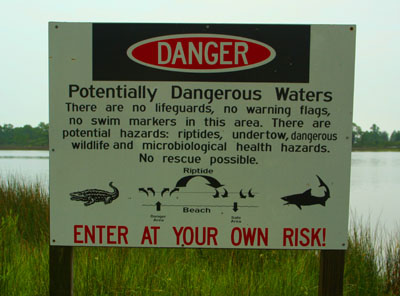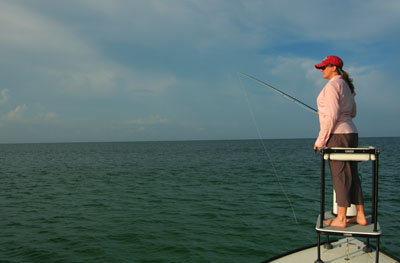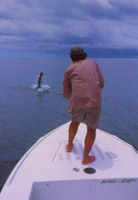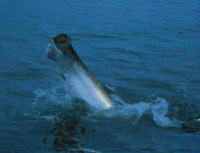Charity and I always do something a little different in the dog days of summer as trout fishing slows down in the Smoky Mountains. Fly fishing for smallmouth bass and backcountry brook trout are two ways we mix it up, but we always head for the saltwater whenever we get the chance. We blocked a few days off at the first of August to fly fish for tarpon with our good friend Alan Steele of Blue Bay Outfitters in northwest Florida. Tarpon fishing is something that we absolutely love but haven’t gotten to do in a few years. We were fortunate to get over a few tarpon in Belize last February, but it’s been a while since we’ve been on a dedicated tarpon trip.
My favorite spots to go fishing always seem to be at the end of a dirt road. Add the perceived danger of venomous snakes or rabid bears to the remote location and the number of fish seems to increase plus they just seem greedier towards a fly. Shortly before our arrival in Alan gave us directions where to meet him at 5:45 AM. The directions included a sand road that ended at the water so I was immediately optimistic.

I mean is this a good spot or what?
We met Alan for the first of two days of tarpon fishing and were in the spot before the sun rose over the horizon. The weather forecast was sketchy, but not enough to deter us from fishing.
The key to tarpon fishing is seeing the fish. The ocean is a big place and blind casting is worthless. Glare is the tarpon angler’s worst enemy since it reduces visibility in the water. Glare is a given early in the morning when the angle of light is low, particularly when you have to look into the sun. Glare is also a problem under overcast conditions. Since there is no direct sunlight the water reflects the greasy grey of the sky. Again, this makes visibility poor. Sometimes you can see a short window in the water off one side of the boat, but one narrow spot is far less favorable than being able to see clearly for several hundred feet on almost all sides.
While visibility is at a minimum the best thing an angler can look for is a tarpon rolling. Tarpon are an ancient fish that haven’t changed at all since the times of the dinosaurs. While they breath with gills just like other fish, they also have sort of lung and will roll on the surface to get a breath of air. Even in the 21st century very little is known about tarpon and no one really knows for sure why these fish will take an occasional breath on the surface.

Alan scans the water for rolling tarpon.
As a tarpon rolls on the surface an angler can try to judge its direction of movement and the speed it’s moving. This isn’t necessary if you have the visibility to see the fish moving through the water. However, if the glare is bad this might be the only clue you have as to where a tarpon is and where it’s going. This is exactly what we did that first morning and actually had a couple of half way decent shots.
Unfortunately as the sun got higher cloud cover began to build in and the visibility never got any better. It was obvious Alan had the boat parked in the perfect spot. Every so often a tarpon would almost bounce off the side of the boat before we saw it. The clouds continued to build to the point where a heavy downpour started and we ran back to the ramp. We had the choice of sitting in the rain or waiting it out from the comfort of a nearby restaurant and chose the latter.
Tarpon fishing is largely a waiting game. Even when the fishing is red hot you’ll spend far more time scanning the horizon than casting. The fish are on the move and the shots you get are fleeting. Take your eye off the water for a few seconds and the best opportunity of the day might come and go before you know what happened.

Imagine this for at least 90% of your time tarpon fishing.
By the end of the day we got perhaps three or four quality shots but no eats. There were two occasions when the tarpon spooked off the fly. Tarpon are funny creatures. Often over 100 pounds they can eat large fish and are only hunted by the largest sharks in the ocean. This doesn’t keep them from fearing something as small as a tarpon fly though. Since they are near the top of the food chain they are used to almost everything getting out of their way. As a result they have an extreme fear of anything that approaches them instead of running away. This is the key to presenting a fly to a tarpon. The best presentation is one that puts the fly in front of the fish but allows the angler to strip the fly away from the fish. The dream shot is when the tarpon is swimming directly towards you. You cast the fly directly into the path of the fish and strip it back as the fish swims towards you. This keeps the fly in the tarpon’s face and gives the impression that is trying to run.
Crossing shots are common and can work, but have inherent problems. If a tarpon crosses you and the only presentation you can get is 90 degrees to the fish you should take the shot, but timing is critical. If you strip the fly too fast it’s possible to do so before the fish will see it. If you wait too long to begin your retrieve it’s possible that the fly will come right into the side of the fish’s face. This will almost guarantee a spooked tarpon. The best thing that can happen is that the fly will cross closely in front of the tarpon and the tarpon will eat it. This has worked for us in the past, but it’s not the ideal arrangement. Since the fly is only in front of the fish for a second or two your chances for the fish to eat are not near as great as they are when the fly is in front of the fish for much longer.


This is what happens when you get it right.
By the end of the second day of fishing we had endured another day of poor visibility and only a few shots at tarpon. Charity got a cast in front of a fish that may have exceeded 120 pounds but completely ignored her offering. I got one half hearted follow and had another fish spook off the fly. It was our first complete blow out in a number of trips. We typically hook several fish and land at least one or two. In fact, we’ve managed to hook up with tarpon on trips when redfish, snook, or bonefish were the primary target but had the appropriate tackle handy. While we didn’t hook any tarpon this trip we did get to spend a couple of days in a beautiful setting and saw some really cool stuff. We saw several loggerhead turtles, two of which were huge. They surfaced near the boat and had a head at least as big as ours. Truly impressive animals. We’re already anticipating our next trip for tarpon, hoping we’ve paid our dues for success.